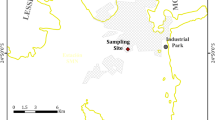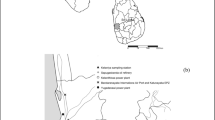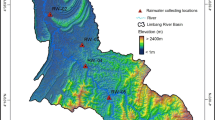Abstract
The present study investigates the chemical composition of rainwater (RW) from a high-altitude site “Nainital” (1958 m above msl) in the central Himalaya region, to understand the influence of local, regional, and long-range transport of pollutants. A total of 55 (2 in pre-monsoon and 53 in monsoon) RW samples were collected during the study period (June–September 2012) and were analyzed for major anions and cations using an ion chromatograph. The pH of precipitation events ranged from 4.95 to 6.50 (average 5.6 ± 0.3) was observed during the monsoon period (near to the acidic), whereas during the pre-monsoon, the pH was 6.25 ± 0.49 (alkaline) over the study region; it is due the mixture of anthropogenic as well as the natural chemical constituents. The average ionic concentration (sum of measured chemical constituents) was ∼3 times higher during the pre-monsoon (986 ± 101 μeq/1) compared to that in the monsoon season (373 ± 37 μeq/1). This is mainly due to the presence of more natural aerosols in the pre-monsoon season which is also reflected in the pH of rainwater (average 6.25 ± 0.50) as well as ionic concentration. The chemical composition suggests that Ca2+ was the major contributor (34%) among cations, followed by Na+ (10%), K+ (8%), and Mg2+ (9%), whereas Cl−, NO3 −, and SO4 2− contributed ∼13, 11, and 9%, respectively, among anions. The average ratio of acidic species (SO4 2−/NO3 −) is 1.56, suggesting 61 and 39% contribution of SO4 2− and NO3 −, respectively, which is very close to the estimated contribution of H2SO4 (60–70%) and HNO3 (30–40%) in the precipitation samples. Neutralization factors for Ca2+, Mg2+, and NH4 + in RW at Nainital are 4.94, 1.21, and 0.37, respectively, indicating their crucial role in neutralization of acidic species. The non-sea-salt (NSS) contribution to total Ca2+, K+, and Mg2+ is estimated to be ∼98, 97, and 74%, respectively, suggesting the dominance of crustal sources for cations. In contrast, the NSS contribution to the total Cl− and SO4 2− is 16 and 69% indicating their anthropogenic origin, respectively. Principle component analysis also suggests that the first factor (i.e., natural sources, mainly dust, and sea-salts) accounts for ∼33% variance, whereas the second factor (i.e., fossil fuel and biomass burning) accounts for ∼18% variance of the measured ionic composition. The remaining contributions are attributed to the mixed emission sources and transport of pollutants from Indo-Gangetic Plain (IGP) and western parts of India. The results of the present study reveal a significant contribution of crustal and anthropogenic sources in the RW and neutralization processes in the central Himalaya.






Similar content being viewed by others
References
Agrawal M, Singh RK (2001) Effect of industrial emission on atmospheric wet deposition. Water Air and Soil Poll 130:481–486
Aiuppa A, Bonfanti P, Alessandro WD (2003) Rainwater chemistry at Mt Etna (Italy): natural and anthropogenic sources of major ions. J Atmos Chem 46:89–102
Akpo AB, Galy-Lacaux C, Laouali D, Delon C, Liousse C, Adon M, Gardrat E, Mariscal A, Darakpa C (2015) Precipitation chemistry and wet deposition in a remote wet savannah site in West Africa: Djougou (Benin). Atmos Environ 115:110–123
Al-Khashman OA (2005) Study of chemical composition in wet atmospheric precipitation in Eshidiya area, Jordan. Atmos Environ 39:6175–6183
Al-Momani I, Tuncel S, Eler U, Ortel E, Sirin G, Tuncel G (1995) Major ion composition of wet and dry deposition in the eastern Mediterranean basin. Sci Total Environ 164:75–85
Avila A, Alarcon M (1999) Relationship between precipitation chemistry and metrological situations at a rural site in NE Spain. Atmos Environ 33:1663–1667
Baez AP, Belmont RD, Garcia RM, Torres MC, Padilla HG (2007) Rainwater chemical composition at two sites in Central Mexico. Atmos Res 80:67–85
Balachandran S, Khilare PS (2001) Occurrence of acid rain over Delhi. Environ Monit Assess 71:165–176
Balasubramanian R, Victor R, Begum R (1999) Impact of biomass burning on rainwater acidity and composition in Singapore. J Geophys Res 104:26881–26890
Bayraktar H, Turalioglu FS (2005) Composition of wet and bulk deposition in Erzurum, Turkey. Chemosphere 59:1537–1546
Beiderwieden E, Wrzesinsky T, Klemm O (2005) Chemical characterization of fog and rain water collected at the eastern Andes cordillera. Hydrol Earth Sys Sci Discuss 2:863–885 www.copernicus.org/EGU/hess/hessd/2/863/
Bisht DS, Tiwari S, Srivastava AK, Singh JV, Singh BP, Srivastava MK (2015) High concentration of acidic species in rainwater at Varanasi in the Indo Gangetic-Plains, India. Nat Hazards 75:2985–3003
Budhavant KB, Rao PSP, Safai PD, Ali K (2009) Chemistry of monsoon and post-monsoon rains at a high altitude location, Sinhagad, India. Aerosol and Air Qual Res 9:65–79
Cao YZ, Wang S, Zhang G, Luo J, Lu S (2009) Chemical characteristics of wet precipitation at an urban site of Guangzhou, South China. Atmos Res 94:462–469
Cheng Y, Engling G, He KB, Duan FK, Ma YL, Du ZY, Liu JM, Zheng M, Weber RJ (2013) Biomass burning contribution to Beijing aerosol. Atmos Chem Phys 13:7765–7781
Choi BY, Yun ST, Yeom G, Kim KH, Koh YK (2008) Spatio-temporal variation of pH and ionic concentrations in precipitation: interaction between two contrasting stationary sources affecting air quality. Geosciences J 12:205–213
Das R, Das S, Misra V (2005) Chemical composition of rainwater and dust fall at Bhubaneswar in the east coast of India. Atmos Environ 39:5908–5916
Das N, Das R, Chaudhury GR, Das SN (2010) Chemical composition of precipitation at background level. Atmos Res 95:108–113
Draxler RR, Rolph GD (2003) HYSPLIT (HYbrid Single-Particle Lagrangian Integrated Trajectory) model access via NOAA ARL READY . NOAA Air ResourcesLaboratory, Silver SpringWebsite (http://www.arl.noaa.gov/ready/hysplit4.html)
Flues M, Hamma P, Lames MJL, Dantas ESK, Fornaro A (2002) Evaluation of the rainwater acidity of a rural region due to a coal-fired power plant in Brazil. Atmos Environ 36:2397–2404
Gajananda K, Kuniyal JC, Momin GA, Rao PSP, Safai PD, Tiwari S, Ali K (2005) Trend of atmospheric aerosols over the north western Himalayan region, India. Atmos Environ 39:4817–4825
Gobre T, Salve PR, Krupadam RJ, Bansiwal A, Shastry S, Wate SR (2010) Chemical composition of precipitation in the coastal environment of India. Bull Environ Contam Toxicol 85:48–53
Granat L, Suksomsankh K, Simachaya S, Tabucanon M, Rodhe H (1996) Regional background acidity and chemical composition of precipitation in Thailand. Atmos Environ 30:1589–1596
Granat L, Das SN, Thakur RS, Rodhe H (2001) Atmospheric deposition in rural areas of India net and potential acidity. Water Air Soil Pollut 130:469–474
Kaya G, Tuncel G (1997) Trace element and major ion composition of wet and dry deposition in Ankara, Turkey. Atmos Environ 31:3985–3998
Keene WC, Pszenny AA, Galloway JN, Hawley ME (1986) Sea-salt corrections and interpretation of constituent ratios in marine precipitation. J Geophys Res 91:6647–6658
Khemani LT, Momin GA, Rao PSP, Pillai AG, Safai PD, Mohan K, Rao MG (1994) Atmospheric pollutants and their influence on acidification of rain water at an industrial location on the west coast of India. Atmos Environ 28:3145–3154
Khwaja HA, Husain L (1990) Chemical characterization of acid precipitation in Albany, New York. Atmos Environ 24:1869–1882
Kulshrestha UC, Sarkar AK, Srivastava SS, Parashar DC (1996) Investigation into atmospheric deposition through precipitation studies at New Delhi (India). Atmos Environ 30:4149–4154
Kulshrestha UC, Monika JT, Prabhat K, Sarkar A (1999) Measurements of atmospheric aerosols at New Delhi during INDOEX pre-campaigns. Curr Sci 76(7):968–972
Kulshrestha UC, Kulshrestha MJ, Sekar R, Sastry GSR, Vairamani M (2003) Chemical characteristics of rainwater at an urban site of south Central India. Atmos Environ 37:3019–3026
Kulshrestha UC, Granat L, Engardt M, Rodhe H (2005) Review of precipitation chemistry studies in India—a search for regional patterns. Atmos Environ 39:7403–7419
Kuniyal JC, Jain AP (1999) Public involvement in environmental assessment of solid waste management in UP Himalayan tourists’ treks, India. Environ Waste Manag 2:279–291
Kuniyal JC, Rao PSP, Momin GA, Safai PD, Tiwari S, Ali K (2007) Trace gases behaviour in sensitive areas of the northwestern Himalaya—a case study of Kullu-Manali tourist complex, India. Indian J Radio Space Phys 36:197–203
Kuniyal JC, Thakur A, Thakur HK, Sharma S, Pant P, Rawat PS, Moorthy KK (2009) Aerosol optical depths at Mohal-Kullu in the northwestern Indian Himalayan high altitude station during ICARB. J Earth Syst Sci 118:41–48
Liu Y, Geng Z, Hou S (2010) Spatial and seasonal variation of major ions in Himalayan snow and ice: a source consideration. J Asian Earth Sci 37:195–205
Migliavacca D, Teixeira EC, Wiegand F, Machado ACM, Sanchez J (2005) Atmospheric precipitation and chemical composition of an urban site, Guaiba hydrographic basin, Brazil. Atmos Environ 39:1829–1844
Moller A, Muller HW, Abdullah A, Abdelgawad G, Utermann J (2005) Urban soil pollution in Damascus, Syria: concentrations and patterns of heavy metals in the soils of the Damascus Ghouta. Geoderma 124:63–71
Momin GA, Ali K, Rao PSP, Safai PD, Chate DM, Praveen PS, Rodhe H, Granat L (2005) Study of chemical composition of rainwater at an urban Pune and a rural Singhagad location in India. J Geophys Res 110:D08302
Moody JL, Pszenny AAP, Gaudry A, Keene WC, Galloway JN, Pollian G (1991) Precipitation composition and its variability in southern Indian Ocean: Amsterdam 1980–87. J Geophys Res 96:769–786
Mouli PC, Venkata MS, Jayarama RS (2005) Rainwater chemistry at a regional representative urban site: influence of terrestrial sources on ionic composition. Atmos Environ 39:999–1008
Norman M, Das AN, Pillai AG, Granat L, Rodhe H (2001) Influence of air mass trajectories on the chemical composition of precipitation in India. Atmos Environ 35:4223–4235
Obaidy AHMJA, Joshi H (2006) Chemical composition of rainwater in a tropical urban area of northern India. Atmos Environ 40:6886–6891
Ozlem I (2006) Investigation of 8 years long composition record in the eastern Mediterranean precipitation. MS thesis. Department of Environmental Engineering, Middle East Technical University, Ankara
Pandey J (2008) Microbial biomass at land water interface and its role in regulating ecosystem properties of a fresh water dry tropical woodland lake. J Environ Biol 29:333–337
Pandey J, Pandey U (2009) Accumulation of heavy metals in dietary vegetables and cultivated soil horizon in organic farming system in relation to atmospheric deposition in a seasonally dry tropical region of India. Environ Monit Assess 148:61–67
Pant P, Hegde P, Dumka UC, Sagar R, Satheesh SK, Moorthy KK, Saha A, Srivastava MK (2006) Aerosol characteristics at a high-altitude location in central Himalayas: optical properties and radiative forcing. J Geophys Res 111:D17206
Parashar DC, Granat L, Kulshreshta UC, et al., (1996) A preliminary report on an indo-Swedish project on atmospheric chemistry. Department of Meteorology, Stockholm University and International Meteorological Institute in Stockholm, Report CM 90
Ram K, Sarin MM, Hegde P (2008) Atmospheric abundances of primary and secondary carbonaceous species at two high-altitude sites in India: sources and temporal variability. Atmos Environ 42:6785–6796
Ram K, Sarin MM, Hegde P (2010) Long-term record of aerosol optical properties and chemical composition from a high-altitude site (Manora Peak) in central Himalaya. Atmos Chem Phys 10(23):11791–11803
Rastogi N, Sarin MM (2005) Chemical characteristics if individual rain events from a semi-arid region in India: three-year study. Atmos Environ 39:3313–3323
Rodhe H, Dentener F, Schulz M (2002) The global distribution of acidifying wet deposition. Environ Sci Techno 36:4382–4388
Roy A, Chatterjee A, Tiwari S, Sarkar C, Das SK, Ghosh SK, Raha S (2016) Precipitation chemistry over urban, rural and high altitude Himalayan stations in eastern India. Atmos Res 116:44–53
Sagar R, Kumar B, Dumka UC, Moorthy KK, Pant P (2004) Characteristics of aerosol spectral optical depths over Manora Peak: a high-altitude station in the central Himalayas. J Geophy Res 109:D06207
Salve PR, Gobre T, Lohkare H, Krupadam RJ, Bansiwal A, Ramteke DS, Wate SR (2011) Source identification and variation in the chemical composition of rainwater at coastal and industrial areas of India. J Atmos Chem 68:183–198
Saxena A, Kulshrestha UC, Kumar N, Kumari KM, Srivastava SS (1996) Characterisation of precipitation at Agra. Atmos Environ 30:3405–3412
Seinfield JH (1986) Atmospheric chemistry and physics of air pollution, vol 219. Wiley, New York
Shrestha AB, Cameron P, Wake JE, Dibb SI (2002) Whitlow aerosol and precipitation chemistry at a remote Himalayan site in Nepal. Aerosol Sci Technol 36:441–456
Singh AK, Mondal GC, Kumar S, Singh KK, Kamal KP, Sinha A (2007) Precipitation chemistry and occurrence of acid rain over Dhanbad, coal city of India. Environ Monit Assess 125:99–110
Srivastava AK, Pant P, Hegde P, Singh S, Dumka UC, Naja M, Singh N, Bhavanikumar Y (2011) The influence of a south Asian dust storm on aerosol radiative forcing at a high-altitude station in central Himalayas. Intern J Remote Sensing 32(22):7827–7845
Srivastava AK, Ram K, Pant P, Hegde P, Joshi H (2012) Black carbon aerosols over central Himalayas: implications to climate forcing. Environ Res Lett 7:014002
Srivastava AK, Soni VK, Singh S, Kanawade VP, Singh N, Tiwari S, Attri SD (2014) An early south asian dust storm during march 2012 and its impacts on Indian Himalayan foothills: a case study. Sci Total Environ 493:526–534
Srivastava AK, Ram K, Singh S, Kumar S, Tiwari S (2015) Aerosol optical properties and radiative effects over manora peak in the Himalayan foothills: seasonal variability and role of transported aerosols. Sci Tota Environ 502:287–295
Tiwari S, Chate DM, Bisht DS, Srivastava MK, Padmanabhamurty B (2012) Rainwater chemistry in the north western Himalayan region of India. Atmos Res 104:128–138
Tiwari S et al (2015) Nature and sources of ionic species in precipitation across the Indo-Gangetic Plains. India Aerosol and Air Quality Research. doi:10.4209/aaqr.2015.06.0423
Tiwari S et al (2016) Significant cooling effect on the surface due to soot particles over Brahmaputra River Valley region, India: an impact on regional climate. Sci Total Environ 562:504–516. doi:10.1016/j.scitotenv.2016.03.157
Tuncer B, Bayar B, Yeşilyurt C, Tuncel G (2001) Ionic composition of precipitation at the central Anatolia (Turkey). Atmos Environ 35:5989–6002
Wai KM, Lin NH, Wang SH, Dokiya Y (2008) Rainwater chemistry at a high-altitude station, Mt. Lulin, Taiwan: comparison with a background station, Mt. Fuji. J Geophys Res 113:D06305
WMO (1994) In: Mohnen V, Santroch J, Vet R (Eds.) Report of the workshop on precipitation chemistry laboratory techniques, Hradec Kralove, Czech Republic 17–21 October. WMO Report no 102
Yang F, He K, Lei Y, Ma Y, Yu X, Tanaka S, Okuda K, Iwase T (2004) Chemical characters of atmospheric precipitation in Beijing in years of 2001–2003, (in Chinese with English abstract), China. Environ Sci 24:538–541
Acknowledgements
The authors are thankful to the Director, IITM, for their guidance and unstinted support for this study. The authors are also very grateful to the Ministry of Earth Sciences (Government of India) for providing financial support of Cloud Aerosol Interaction and Precipitation Enhancement Experiment (CAIPEEX).
Author information
Authors and Affiliations
Corresponding author
Additional information
Responsible editor: Gerhard Lammel
Rights and permissions
About this article
Cite this article
Bisht, D.S., Srivastava, A., Joshi, H. et al. Chemical characterization of rainwater at a high-altitude site “Nainital” in the central Himalayas, India. Environ Sci Pollut Res 24, 3959–3969 (2017). https://doi.org/10.1007/s11356-016-8093-z
Received:
Accepted:
Published:
Issue Date:
DOI: https://doi.org/10.1007/s11356-016-8093-z




